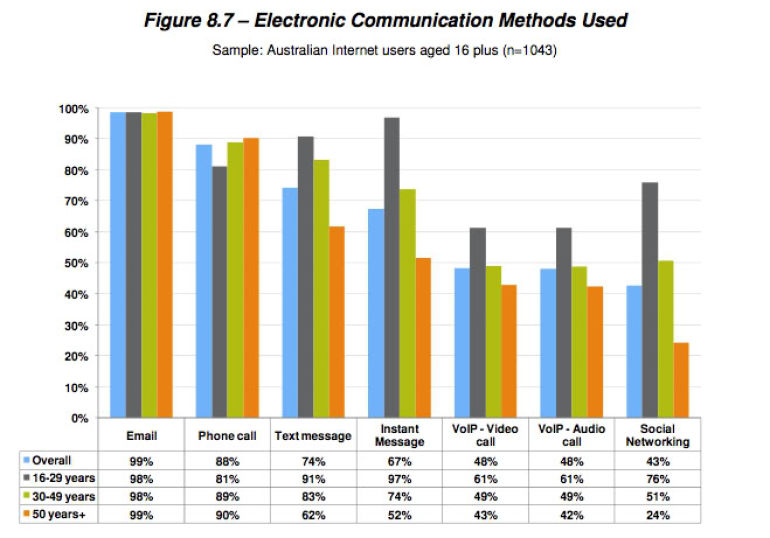Guidelines for communications with your customers
Right. So all businesses communicate with their customers. There are lots of different channels that you can communicate with your customers through (eg phone, email) and a variety of different standards that you can apply to these communications. You can see the ways your customers prefer to communicate in the figure below.
While there are many different things to talk about when it comes to customers service, this article focuses specifically on promises.
What's the point of making a service promise?
In large organisations, the marketing departments will talk to the operations teams and decide what kind of service promise they can make to their customers - both current and prospective. Then, they will broadcast that message in various ways - either comparing it to their competitors promises or simply by making the promise.
Defining a service promise, otherwise known as a service level agreement, is not only useful as a marketing tool to increase customers' trust in your organisation, but it's also useful for your internal workings and the understanding of everyone in the business - no matter how big or small your business is. Making sure everyone is on the same page and offering the same service is valuable when setting expectations for yourself and your staff. It's even important to be on the same page as yourself to make sure you're acknowledging that you're doing it right. Things like answering phone calls between certain times, how quickly you return messages, how long will an email wait before the customer gets a response - all are important things to think about.
Making your service promise
Because each business is different, and has different operations and service channels, we're not able to give you a definite guideline on what kind of service promise you should be making. But we can suggest that you should definitely be either reviewing your service promise once a year at least, or creating one if you don't have one. And we can also give you a framework for deciding what's important and a little advice.
So, what are the things to think about when you're thinking about setting up a service level agreement between you and your customers?
What servicing channels do you have?
For service each channel you have, you can have a separate or different service promise. Channels to think about are landlines and mobile phones, email, faxes, letters, social media and Service Central reminders + updates. Let's look at them all in detail.
Making a service promise for each service channel
Landlines (all of them) and Mobile phones
Most businesses will prioritise the telephones (both mobile and landline) over everything else. Think about these questions.
How many calls will you allow to go to voicemail? Aiming to answer a 90% of calls is a good start, because voicemail tag is both frustrating for your customers and inefficient and costly for your business.
How many times should you let the phone ring before answering it? 3 rings is excellent, 5 is reasonable but edging on poor, and by around 7 rings customers contemplate hanging up and then, most of them do.
How fast will you return voicemail messages? This can vary according to what's possible but of course the sooner the better - but remember our tip about good voicemail messages? In your message it's helpful to give the caller who just left a voicemail an idea of how long they'll wait before getting a return phone call.
How long will you keep a customer on hold for? A minute is about all a customer can handle - it's too long. Remember, when you're waiting, time passes very very slowly. So what may feel reasonable to you (while you organise, sort out, find out, etc) might not feel as reasonable to your customer.
Email (all addresses if you have more than one)
Prioritising telephone over email is usually warranted, but if your business receives a lot of emails it might be worth making email as high a priority as returning phone calls.
How fast will you respond to emails? This will depend on your business, but 3 days is not a reasonable or professional response time by any means - some companies advertise their response time as 10 days but most professional companies will have a response time of 24 to 48 hours (ie 1 - 2 working days). More and more companies are committing to 'same day' response which basically means that their staff don't go home if there's an email to respond to.
Faxes
As far as we know, fax communication for queries has all but died out - except to receive authorisation forms, order forms, things with signatures etc. The question to ask is, as usual:
How long will a response take? As most fax communication is about requesting services, we'd recommend that these items be prioritised highest - receive, action, confirm. If the actioning of their request is going to take longer than a day, will a courtesy phonecall be made?
Letters
When was the last time you received a business letter that was from a customer and wasn't a bill? Still important to question how long a response should take, and you might also then want to think about the avenue of response - should you write back or use another channel?
Social media eg Facebook
It might be strange to think about it, but social media like Facebook is also a customer service channel. However, not all types of social media interactions really need a response - but this will be up to you. So:
Which types of social media will you respond to? As a general rule, responding to a 'like' on your status update isn't necessary, and comments aren't either. But direct messages, posts on walls, tweets aimed at your company - these are all inviting a response. Just use your head - it's a new playing field and you can pretty much set your own rules at the moment.
Of those, how fast will you respond? Social media is far more fast paced that email or even the telephone - people expect responses relatively fast, especially if they can see you've been 'on' social media. Remember also that social media displays in absolute terms how long it's taken your business to respond, and ALL of your customers can see this so it's a good opportunity to show off your customer service promise.
Service Central feedback updates and reminders
As part of your Service Central membership, we give your customers the opportunity to communicate directly with you using our system. They can remind you to call or quote (only after 24 hours has passed since you picked up the job) and can also leave feedback on your profile. Every time this happens, you'll get either a text or email (depending on how your account is set up) to let you know.
How soon will you respond? We'd recommend you prioritise these well up at the top of your pile, but then of course that's what we'd say! Still, reminders to call or quote are from people who are interested to receive service from your company and haven't, up until this stage, received it. They are good sales opportunities provided you can turn them around and correct any failures that may have happened in the past. Your feedback online is higher priority if it's negative feedback - and not all feedback requires an action.
So to sum up
- Evaluate which service channels you have
- Decide what your service promise is going to be, preferably in collaboration with staff that may need to keep to this service promise
- Decide whether to market your service promise
Then, over and above your service promise, you may also want to look at your business and the types of queries that you get, and evaluate them for 'types'. Think about types of queries that may be of higher priority even than just your service promise. There won't be examples here in every business but it's good to think about!
Nielsen Internet and Technology report (February 2010)



